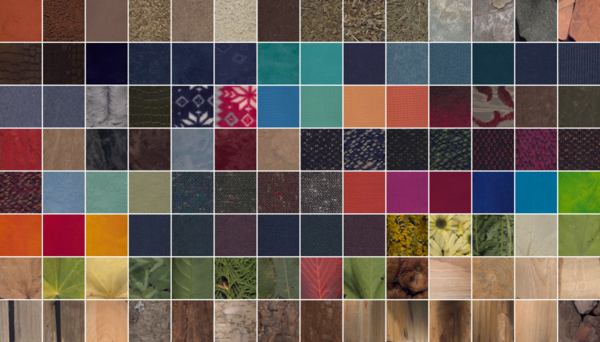HyTexiLa is a dataset of hyperspectral reflectance images that span visible (VIS) and near infrared (NIR) parts of the electromagnetic spectrum of 112 textured materials. These materials fall into five different categories: textile (65 samples), wood (18 samples), vegetation (15 samples), food (10 samples) and stone (4 samples).
This dataset is available here for non-commercial research use. An overview of color versions of images is available below.

If this dataset is used in an academic publication, please cite the following paper:
Khan, H.A.; Mihoubi, S.; Mathon, B.; Thomas, J.-B.; Hardeberg, J.Y. HyTexiLa: High resolution visible and near infrared hyperspectral texture images. Sensors 2018, 18, 2045. [SENSORS] [BibTex]
Images have been acquired using the HySpex VNIR-1800 hyperspectral camera, manufactured by Norsk Elektro Optikk AS and coupled with a close-up lens with a working distance of 30 cm. Spatial distortions of resulting radiance images have been then corrected. The illuminant has been estimated from the SG-3051 SphereOptics Diffuse Reflectance Tile and the radiance images have been divided by this estimate to obtain reflectance images. Each reflectance image is of dimensions 1024 x 1024 x 186, where 1024 x 1024 is the spatial resolution, and 186 is the number of spectral channels. These channels are associated to spectral bands centered at wavelengths which range from 405.37 nm to 995.83 nm at 3.19 nm intervals.
Each one of the 112 reflectance images is provided as both:
- hyperspectral image in ENVI format;
- sRGB reconstructed image in PPM format.
The ENVI format consists of two files: a binary file (extension .raw) of single-precision floating-point variables (32-bit) that stores the raw hyperspectral reflectance image in the BSQ (Band SeQuential) data organization (channel by channel) and a text file (extension .hdr) which contains the metadata of the image.
We provide ImageJ plugins (Multispectral Tools) and Python code for opening and processing the data. Matlab users can call the following instruction to open an image:
R = multibandread(’<image_name>.raw’,[1024,1024,186],’float32’,0,’bsq’,’ieee-be’);
For texture classification purposes, we propose a benchmark based on a training/testing split of subimages of HyTexiLa reflectance images described in two text files:
- test.txt: contains, for each test subimage, its full image filename, its bounding box (x0, y0, x1, y1) and its true class number;
- train.txt: contains, for each train subimage, its full image filename, its bounding box (x0, y0, x1, y1) and its true class number.
where:
- number of subimages are written in the first line of each text file;
- (x0, y0) are the coordinates of the top left pixel of the subimage;
- (x1, y1) are the coordinates of the bottom right pixel of the subimage.
This notice and the HyTexiLa dataset will be also available on the website of the Norwegian Colour and Visual Computing Laboratory.